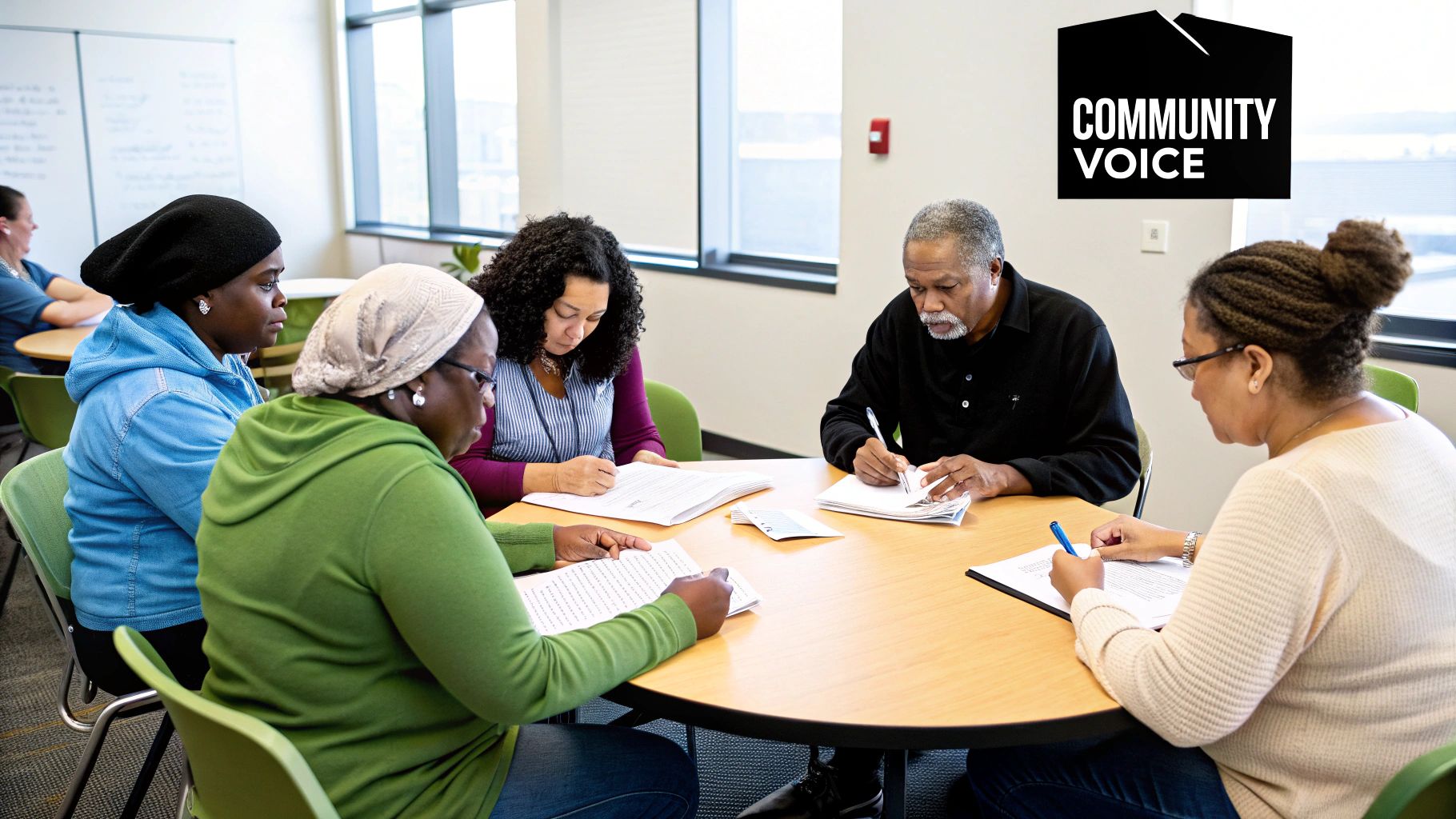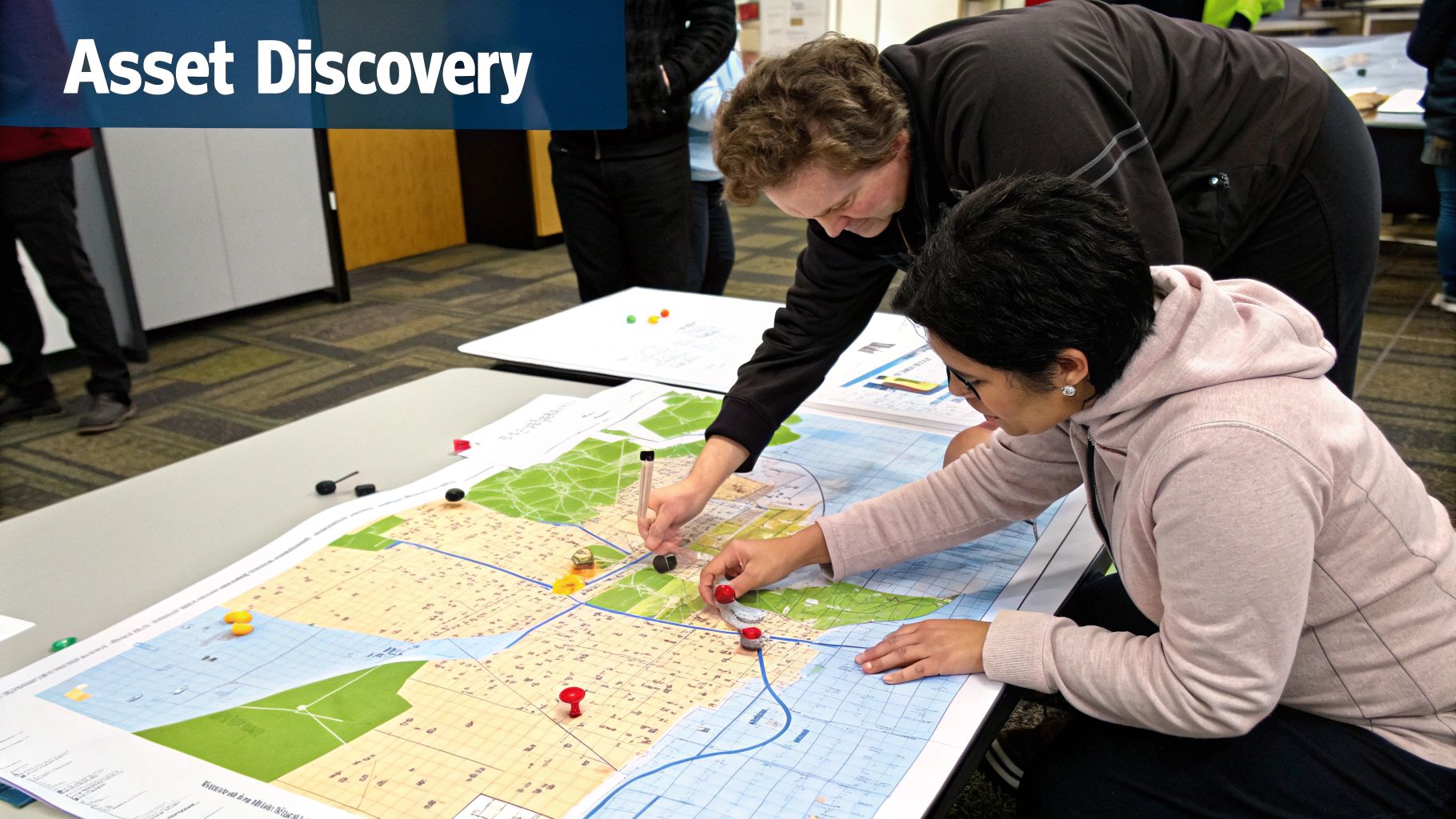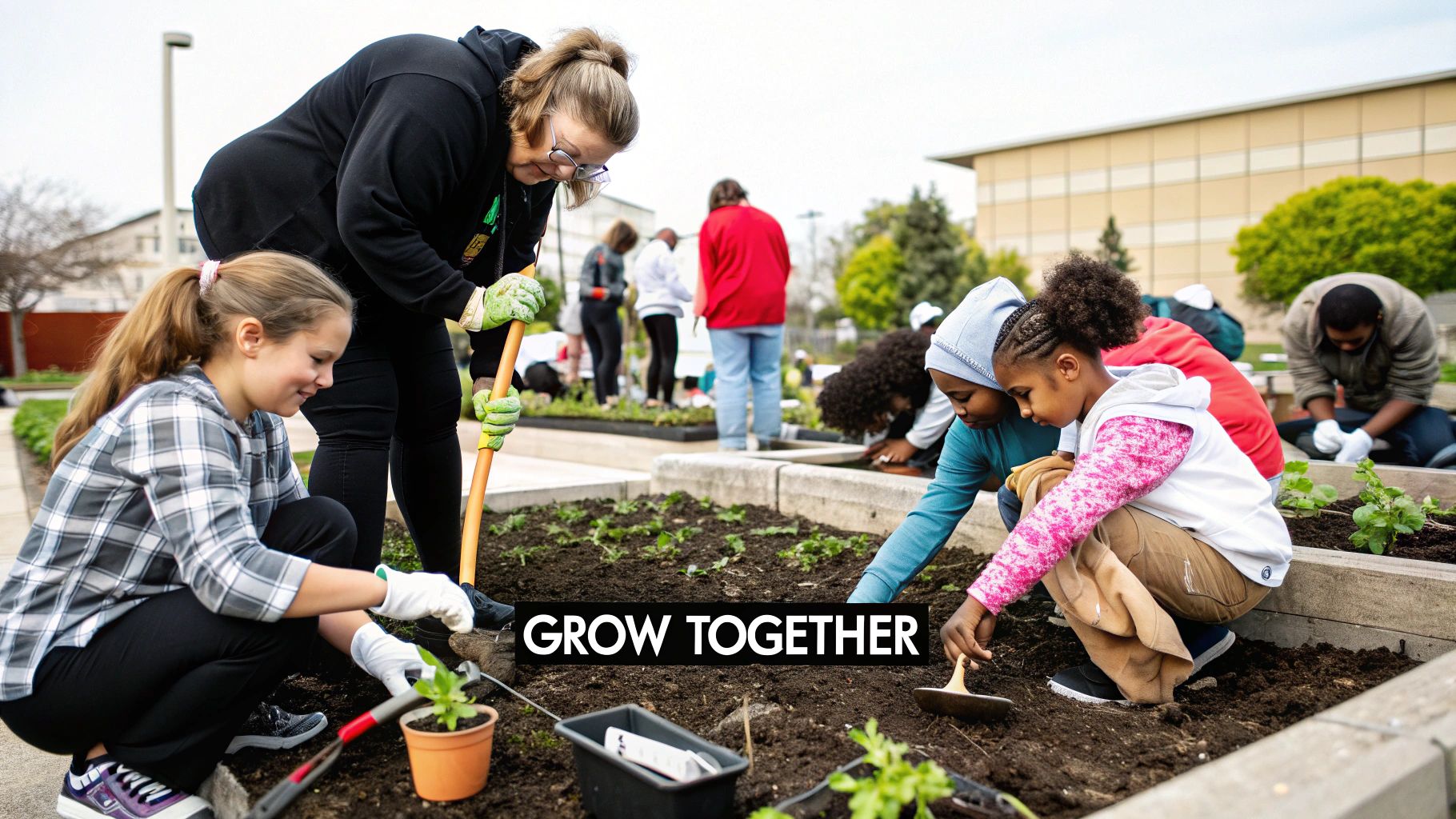Getting Started
Want to build stronger relationships with your community? This listicle explores nine impactful community engagement activities, providing practical implementation tips and real-world examples. Whether you're a small business, a local organization, or a creative freelancer, these strategies will help you connect with your audience authentically. Stronger community engagement translates to increased brand loyalty, more effective initiatives, and a more vibrant local environment. This curated list offers fresh perspectives on familiar concepts and actionable advice for maximizing your impact.
For organizations looking for funding opportunities to support these initiatives, exploring grant options can be invaluable. Resources like the guide on securing grants for community centers from OpenGrants can provide a step-by-step application process.
This list covers a range of activities, from establishing community advisory committees to leveraging digital engagement platforms. We'll explore innovative approaches like participatory budgeting and community asset mapping, along with more traditional methods such as community forums and neighborhood associations. We'll also delve into creative options like community gardens, citizen science projects, and vibrant cultural events. This diverse collection ensures you'll discover specific, actionable strategies relevant to your organization and community.
1. Community Advisory Committees
Community Advisory Committees (CACs) are structured groups that bring together diverse community members to provide ongoing input on local issues, policies, and programs. These committees establish formal channels for citizens to participate in decision-making processes, fostering a sense of ownership and shared responsibility. CACs ensure diverse voices are heard, contributing to more equitable and effective outcomes. They act as a bridge between the community and governing bodies, facilitating two-way communication and collaboration.

Examples of Effective CACs
- Seattle's Community Advisory Councils: These councils focus on police accountability, providing crucial citizen oversight.
- Toronto's Community Advisory Committees: These groups advise on urban planning, shaping the city's development.
- NHS Patient and Public Involvement Groups (UK): These committees ensure patient voices are central to healthcare decisions.
- Environmental Justice Advisory Councils: These councils, found in various US cities, address environmental inequities and advocate for community health.
Implementing a Successful CAC
- Define Clear Objectives: Establish a clear mandate and scope for the committee, outlining its purpose, responsibilities, and decision-making authority.
- Diverse Recruitment: Ensure representation from all segments of the community, including marginalized groups, to capture a broad range of perspectives.
- Structured Governance: Implement clear operating procedures, including meeting frequency, decision-making protocols, and communication strategies.
- Training and Support: Provide committee members with training on governance, meeting facilitation, and relevant topics to enhance their effectiveness.
- Feedback Mechanisms: Demonstrate how community input is used, closing the feedback loop and reinforcing the value of participation. This fosters trust and encourages continued engagement.
When to Utilize a CAC
CACs are invaluable when:
- Addressing complex or controversial issues requiring broad community input.
- Developing new policies or programs with significant community impact.
- Building trust and strengthening relationships between communities and governing bodies.
- Promoting transparency and accountability in decision-making processes.
Learn more about Community Advisory Committees and other community engagement strategies. By empowering communities through structured participation, CACs can contribute to more responsive and effective governance, fostering a stronger sense of collective ownership.
2. Participatory Budgeting
Participatory budgeting (PB) is a democratic process where community members directly decide how to spend part of a public budget. This involves proposal development, deliberation, and voting. Citizens identify local priorities, develop project proposals, and then vote on which projects receive funding, giving them a direct voice in how public resources are allocated. This fosters a sense of ownership and empowers communities to shape their neighborhoods.

Examples of Effective PB
- Porto Alegre, Brazil: The birthplace of PB, demonstrating its potential for transformative community development.
- New York City: PB is used in council districts, allowing residents to decide on local infrastructure projects.
- Paris: A significant portion of the city's budget is allocated through PB, showcasing its scalability.
- Boston's Youth Lead the Change: This program empowers young people to participate in budgetary decisions.
Implementing a Successful PB Process
- Dedicated Budget: Start with a meaningful but manageable budget amount.
- Multiple Participation Channels: Offer online, in-person, and mobile options for participation.
- Project Criteria: Establish clear eligibility criteria for proposed projects.
- Outreach and Accessibility: Invest in multilingual outreach and ensure accessibility for all community members.
- Celebrate Success: Showcase completed projects to demonstrate the impact of community decisions.
When to Utilize PB
Participatory budgeting is a valuable community engagement activity when:
- Distributing limited resources fairly and transparently.
- Addressing hyperlocal needs identified directly by community members.
- Building trust and strengthening relationships between communities and local government.
- Empowering residents to take an active role in shaping their neighborhoods.
Learn more about Participatory Budgeting and discover how this democratic process can enhance community engagement activities and foster a stronger sense of collective ownership.
3. Community Asset Mapping
Community asset mapping is a collaborative process where residents identify, catalog, and leverage existing resources within their community. These resources include skills, organizations, physical spaces, and local connections. This strength-based approach focuses on what communities have rather than what they lack, empowering residents to build upon their existing assets. It promotes community ownership and fosters sustainable development from within.

Examples of Effective Community Asset Mapping
- Asset-Based Community Development Institute's neighborhood mapping initiatives: These initiatives provide training and resources for communities to conduct their own asset mapping projects.
- Chicago's Logan Square asset mapping project: This project identified local businesses, community gardens, and resident skills to inform neighborhood development plans.
- Rural community asset mapping in Appalachian regions: Mapping helps identify resources and address specific challenges like access to healthcare and economic development.
- Indigenous community asset mapping in Canada: This approach supports self-determination by recognizing and valuing traditional knowledge and cultural assets.
Implementing Successful Community Asset Mapping
- Use multiple methods to gather information: Employ surveys, interviews, focus groups, and walking tours to collect comprehensive data.
- Include both tangible and intangible assets: Document physical resources (parks, libraries) and intangible assets (resident skills, social networks).
- Engage diverse community members as mappers: Ensure representation from all segments of the community to capture a full picture of existing assets.
- Create visual, accessible formats for sharing results: Use maps, charts, and online databases to make asset information readily available.
- Connect mapping to specific community goals or projects: Align asset mapping with community development plans, grant applications, or local initiatives.
When to Utilize Community Asset Mapping
Community asset mapping is particularly valuable when:
- Developing community-led initiatives: Asset mapping provides the foundation for building programs based on existing strengths.
- Seeking grant funding: Demonstrating existing assets strengthens grant proposals and showcases community capacity.
- Building partnerships and collaborations: Mapping reveals potential connections and fosters resource sharing among organizations.
- Promoting community ownership and empowerment: Engaging residents in identifying and leveraging their own assets strengthens social capital.
Community asset mapping is a valuable community engagement activity because it fosters collaboration, builds on existing strengths, and empowers residents to shape their own future. By understanding and leveraging their assets, communities can create more sustainable, equitable, and resilient futures.
4. Digital Engagement Platforms
Digital engagement platforms are online tools and platforms that enable communities to participate in discussions, provide feedback, collaborate on projects, and engage with local government or organizations. These platforms leverage technology to expand access to civic participation beyond traditional in-person meetings, offering greater flexibility and reach. They facilitate two-way communication, allowing organizations to share information and gather valuable community input. Digital platforms can foster a sense of shared ownership and empower residents to become active participants in shaping their communities.

Examples of Effective Digital Engagement Platforms
- Decidim: Used by Barcelona and other cities for participatory budgeting and policy development.
- mySidewalk: Provides data visualization tools to help communities understand local trends and inform decision-making.
- Neighborland: Facilitates civic issue reporting, discussion, and collaboration between residents and local government.
- CitizenLab: Offers a comprehensive participation platform used globally for community engagement initiatives.
Implementing a Successful Digital Engagement Platform
- Ensure Mobile-Friendly Design: Prioritize accessibility by ensuring the platform is easily navigable and functional on mobile devices.
- Clear Participation Guidelines: Establish clear guidelines for respectful communication and engagement to foster a positive online environment.
- Combine Digital with Offline: Integrate online engagement with offline activities to create a more holistic and inclusive approach to community participation.
- Technical Support and Training: Provide users with technical support and digital literacy training to overcome barriers to access and participation.
- Demonstrate Impact: Clearly show how online input influences real-world decisions, reinforcing the value of participation and fostering trust.
When to Utilize a Digital Engagement Platform
Digital engagement platforms are particularly beneficial when:
- Reaching a Wider Audience: Expanding participation beyond those able to attend in-person meetings.
- Gathering Diverse Perspectives: Facilitating input from a broader range of community members, including marginalized groups.
- Streamlining Feedback Processes: Collecting and analyzing community feedback efficiently and effectively.
- Promoting Transparency and Accountability: Making community engagement processes more open and accessible.
Learn more about Digital Engagement Platforms and best practices for maximizing their impact. By leveraging technology, digital platforms empower communities to participate actively in shaping their future, leading to more inclusive and responsive governance. These platforms provide invaluable tools for building stronger communities through increased communication and collaboration.
5. Community Forums and Town Halls
Community Forums and Town Halls are open public meetings designed to connect community members with local officials, experts, and each other. They provide a platform for discussing local issues, asking questions, and offering input on policies and decisions. These traditional yet adaptable formats remain vital for democratic participation and can be incredibly effective community engagement activities. These events foster open dialogue and provide valuable insights into public sentiment.
Examples of Effective Forums and Town Halls
- New England Town Meetings: This long-standing tradition empowers residents with direct voting power on local governance.
- Congressional Town Halls (US): These meetings facilitate direct interaction between elected officials and their constituents.
- Community Forums on Police Reform: Many cities have utilized forums to gather community input on vital policing issues.
- Climate Change Town Halls: These events, often organized by environmental groups, raise awareness and encourage community action.
Implementing a Successful Forum or Town Hall
- Professional Facilitation: For potentially controversial topics, a skilled facilitator ensures productive and respectful dialogue.
- Accessibility is Key: Provide childcare and interpretation services to remove barriers to participation.
- Varying Times and Locations: Holding meetings at different times and accessible venues accommodates diverse schedules and needs.
- Breakout Groups: For larger gatherings, smaller breakout sessions allow for more focused discussions and deeper engagement. To broaden your understanding, consider how digital marketing can be used in community engagement: Digital Marketing for Small Business: Your Middle East Success Guide from Grassroots Creative Agency
- Follow Up: Distribute meeting summaries, action steps, and responses to questions, demonstrating that input is valued.
When to Utilize a Forum or Town Hall
Forums and Town Halls are particularly beneficial when:
- Gauging public opinion on proposed policies or projects.
- Addressing community concerns or controversies.
- Facilitating two-way communication between officials and the public.
- Building consensus and fostering collaboration on local issues.
Learn more about Community Forums and Town Halls and other effective methods to foster communication and collaboration within your community. By providing a structured platform for dialogue, these gatherings can strengthen community bonds and improve local governance.
6. Neighborhood Associations and Block Clubs
Neighborhood Associations and Block Clubs are grassroots organizations formed by residents of specific geographic areas. They address local concerns, build community connections, and advocate for neighborhood improvements. These groups focus on hyperlocal issues, fostering ongoing neighbor-to-neighbor relationships and creating a strong sense of community. They empower residents to take ownership of their neighborhoods and work collaboratively towards positive change.
Examples of Effective Neighborhood Organizations
- Seattle's Neighborhood Council System: This system empowers neighborhood groups to advise the city on local issues.
- Chicago's Block Club Network: This extensive network supports block clubs in organizing community events and addressing safety concerns.
- Toronto's Residents' Associations: These associations represent residents on issues like development and park improvements.
- Community Councils (UK): These councils provide a platform for residents to engage with local authorities and influence decisions affecting their communities.
Implementing a Successful Neighborhood Association
- Actively Recruit Diverse Representation: Ensure all demographics within the neighborhood are represented in the association's membership and leadership.
- Focus on Achievable Goals: Start with smaller, concrete projects to build momentum and demonstrate the association's impact.
- Build Relationships with Local Government Liaisons: Establish open communication channels with city officials to effectively advocate for neighborhood needs.
- Organize Social Events: Combine advocacy efforts with social gatherings to build stronger community bonds and attract new members.
- Develop Succession Planning: Create a plan for leadership transitions to ensure the long-term sustainability of the association.
When to Utilize a Neighborhood Association
Neighborhood Associations are particularly valuable when:
- Addressing hyperlocal issues such as traffic calming, park improvements, or neighborhood safety.
- Building a strong sense of community and fostering neighbor-to-neighbor connections.
- Advocating for neighborhood interests in local government decision-making.
- Creating a platform for residents to voice concerns and contribute to positive change.
Learn more about community engagement strategies. By empowering residents to take ownership of their neighborhoods, these associations contribute to safer, more vibrant, and resilient communities. They provide a vital link between residents and local authorities, facilitating collaborative problem-solving and improving the quality of life for all.
7. Community Gardens and Collaborative Projects
Community gardens and collaborative projects offer shared spaces and initiatives where community members work together on tangible projects. These can range from growing food and creating art to improving public spaces. These hands-on activities foster strong relationships while simultaneously achieving visible community improvements. The shared effort creates a sense of ownership and pride, contributing to a more vibrant and connected community.
Examples of Successful Collaborative Projects
- Brooklyn's Community Garden Network: This network provides green spaces for food production, environmental education, and community building across the borough.
- Detroit's Urban Farming Initiatives: These projects transform vacant lots into productive farms, providing fresh food and economic opportunities.
- Philadelphia's Mural Arts Program: This program engages the community in creating public murals, fostering artistic expression and neighborhood beautification.
- Tool Libraries and Maker Spaces: These shared resources, popping up in numerous cities, empower residents with access to tools and equipment for DIY projects and skill-building.
Implementing a Successful Collaborative Project
- Start Small: Begin with manageable projects to build momentum and demonstrate success.
- Clear Agreements: Establish clear agreements about roles, responsibilities, and decision-making processes.
- Educational Components: Incorporate educational workshops or training sessions to enhance participant skills and knowledge.
- Inclusivity: Create welcoming spaces that are accessible and inclusive to individuals of all skill levels and backgrounds.
- Celebrate Milestones: Document and celebrate project milestones to recognize achievements and maintain enthusiasm.
When to Utilize Collaborative Projects
Collaborative projects are particularly effective when:
- Seeking to improve a specific community space or resource.
- Building practical skills and knowledge within the community.
- Creating opportunities for intergenerational connection and collaboration.
- Fostering a sense of community ownership and pride.
Learn more about Community Gardens and Collaborative Projects and how to manage such projects effectively. By working together on shared goals, communities can create tangible positive change and strengthen social bonds.
8. Citizen Science and Community Research
Citizen science and community research programs empower community members to actively participate in the scientific process. Residents collect data, conduct research, and monitor local conditions, contributing valuable insights to inform decision-making. These initiatives effectively combine rigorous scientific methodology with invaluable local knowledge and lived experiences. This fosters a sense of ownership and ensures that research addresses relevant community concerns. By engaging residents directly, citizen science promotes more equitable and effective outcomes.
Examples of Effective Citizen Science
- Community-based participatory research on health disparities: Residents collaborate with researchers to investigate and address local health issues.
- Bucket Brigade air quality monitoring in industrial areas: Community members collect air samples to monitor pollution levels and advocate for environmental justice.
- Community mapping of environmental hazards: Residents identify and document environmental risks, contributing to community safety and resilience.
- Resident-led housing condition surveys: Community members conduct surveys to assess housing quality, informing policy and resource allocation.
Implementing Successful Citizen Science
- Partner with academic institutions or research organizations: Collaborations provide scientific expertise and resources.
- Provide thorough training on data collection methods: Training ensures data quality and accuracy.
- Create protocols for data quality and verification: Establish clear procedures for data management and validation.
- Ensure community ownership of research questions: Involve residents in defining research priorities and questions.
- Plan for how data will be used and shared: Develop strategies for disseminating findings and using data to inform action.
When to Utilize Citizen Science
Citizen science and community research are particularly valuable when:
- Investigating localized issues requiring detailed, community-specific data.
- Addressing environmental or public health concerns that directly impact residents.
- Empowering communities to take an active role in shaping research and policy.
- Bridging the gap between scientific knowledge and community understanding.
Citizen science initiatives, by directly involving communities in the scientific process, can lead to more impactful and relevant research outcomes. This participatory approach not only strengthens community engagement but also promotes more equitable and effective solutions to local challenges.
9. Community Festivals and Cultural Events
Community festivals and cultural events are vibrant celebrations, performances, and gatherings that bring diverse community members together. These events offer opportunities to share traditions, build connections, and strengthen community identity. They effectively combine entertainment with community building, often highlighting local culture and the richness of diversity. By creating a shared experience, festivals foster a sense of belonging and encourage positive interaction among residents.
Examples of Successful Community Festivals and Cultural Events
- National Night Out: These neighborhood celebrations promote police-community partnerships and camaraderie.
- Cultural Heritage Festivals: Found in many diverse communities, these events showcase traditions, food, music, and art from various cultures.
- Local Music and Arts Festivals: These festivals celebrate local talent and provide a platform for artists to connect with the community.
- Community Harvest Festivals and Farmers Markets: These events connect residents with local farmers and producers, fostering a sense of community and supporting local businesses.
Implementing Successful Community Festivals and Cultural Events
- Include Diverse Cultural Programming and Vendors: Represent the diverse cultures within the community to create an inclusive and engaging experience.
- Create Volunteer Opportunities: Empower community members to take ownership and actively participate in the event's success.
- Partner with Local Organizations and Businesses: Leverage existing resources and expertise to enhance the event's impact and reach.
- Make Events Accessible and Family-Friendly: Consider accessibility needs and create an environment welcoming to all ages and abilities.
- Promote Other Community Engagement Opportunities: Use these events as a platform to showcase other ways residents can get involved in the community.
When to Utilize Community Festivals and Cultural Events
Community festivals and cultural events are particularly effective for:
- Celebrating community milestones or achievements.
- Promoting cross-cultural understanding and appreciation.
- Boosting local economic activity and tourism.
- Creating positive media attention and community pride.
- Providing opportunities for social interaction and connection.
Learn more about planning successful Community Festivals and Cultural Events and other community engagement strategies. By offering engaging experiences and promoting inclusivity, festivals can significantly enhance community spirit and create lasting positive impacts.
Community Engagement Activities Comparison
| Item | Implementation Complexity 🔄 | Resource Requirements ⚡ | Expected Outcomes 📊 | Ideal Use Cases 💡 | Key Advantages ⭐ |
|---|---|---|---|---|---|
| Community Advisory Committees | Medium – requires coordination, formal meetings | Moderate – time commitment from diverse participants | Consistent community input; accountability | Long-term governance, policy guidance | Builds trust; diverse perspectives; leadership development |
| Participatory Budgeting | High – multi-stage process with voting | High – staff, expertise, budget allocation | Visible, concrete funded projects | Budget allocation, community-driven spending | Empowers citizens; transparency; tangible impact |
| Community Asset Mapping | Medium – data collection and ongoing updates | Low to moderate – relies on community volunteer time | Strength-based community insights | Community development, resource identification | Reveals hidden assets; builds pride; cost-effective |
| Digital Engagement Platforms | Medium to high – platform setup and moderation | Moderate – tech support and digital tools | Broad reach; data on participation patterns | Expanding access; asynchronous participation | Accessible; scalable; inclusive language and accessibility |
| Community Forums and Town Halls | Low to medium – event organization and facilitation | Low to moderate – venue, facilitation | Direct dialogue; immediate feedback | Public consultation; issue discussion | Direct access to decision-makers; transparent; educative |
| Neighborhood Associations and Block Clubs | Low – grassroots organizing with regular meetings | Low – volunteer-led, minimal funding | Local advocacy; neighborhood cohesion | Hyperlocal issues; resident-led initiatives | Builds social connections; quick mobilization |
| Community Gardens and Collaborative Projects | Medium – project planning and maintenance | Moderate – materials, space, ongoing care | Tangible improvements; relationship building | Hands-on community improvements | Visible outcomes; skill-building; environmental benefits |
| Citizen Science and Community Research | High – training, data protocols, quality control | Moderate to high – training, technical support | Credible data; policy influence | Local research, advocacy, evidence-building | Locally relevant data; community empowerment |
| Community Festivals and Cultural Events | Medium – event planning and coordination | Moderate to high – logistics, vendors, volunteers | Shared experiences; community identity building | Celebrations, cultural sharing | Builds pride; economic activity; diverse participation |
Final Thoughts
This collection of community engagement activities provides a diverse toolkit for fostering stronger connections and driving positive change. From establishing advisory committees to leveraging digital platforms and celebrating local culture, the options are vast and adaptable to various community contexts. The key takeaway is that successful community engagement requires a thoughtful, proactive, and sustained approach.
The Power of Participation
Remember that genuine engagement goes beyond simply informing residents. It involves actively involving them in decision-making processes, valuing their input, and empowering them to shape their community. Whether it's participatory budgeting or contributing to citizen science initiatives, each activity offers a unique avenue for building trust and fostering a sense of shared ownership. Attending community festivals is a great way to connect with local residents, just like this wedding band playing at Main Street Fest. Such events can be catalysts for spontaneous collaboration and connection.
Creating Sustainable Impact
Effective community engagement activities create a ripple effect. They not only address immediate needs but also contribute to long-term community well-being. By investing in these strategies, you are investing in the future of your community. Consider the potential impact of a thriving community garden, a successful neighborhood association, or a well-attended community forum. These initiatives can lead to stronger social networks, improved local infrastructure, and increased civic participation.
Taking the Next Step
Mastering these community engagement activities is crucial for building vibrant, resilient, and thriving communities. It enables you to tap into the collective wisdom and energy of your residents to achieve shared goals. Start small, experiment with different approaches, and adapt your strategies based on the unique needs and characteristics of your community.
Need help brainstorming, planning, and executing engaging community initiatives? Creativize offers tools and resources to streamline your community engagement efforts and maximize your impact. Visit Creativize today to learn more.

